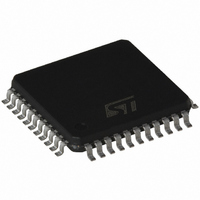TDA7406TR STMicroelectronics, TDA7406TR Datasheet - Page 41

TDA7406TR
Manufacturer Part Number
TDA7406TR
Description
IC PROCESSOR CAR SIGNAL 44-TQFP
Manufacturer
STMicroelectronics
Type
Car Signal Processorr
Datasheet
1.TDA7406TR.pdf
(64 pages)
Specifications of TDA7406TR
Applications
Automotive Systems
Mounting Type
Surface Mount
Package / Case
44-TQFP, 44-VQFP
Lead Free Status / RoHS Status
Lead free / RoHS Compliant
Available stocks
Company
Part Number
Manufacturer
Quantity
Price
Company:
Part Number:
TDA7406TR
Manufacturer:
STMicroelectronics
Quantity:
10 000
TDA7406
9.3
9.3.1
9.3.2
9.3.3
9.3.4
Additional Threshold Control Mechanism
Automatic Threshold Control by the Stereoblend voltage
Besides the noise controlled threshold adjustment there is an additional possibility for
influencing the trigger threshold which depends on the stereoblend control.
The point where the MPX signal starts to become noisy is fixed by the RF part. Therefore
also the starting point of the normal noise-controlled trigger adjustment is fixed (fig. 20). In
some cases the behavior of the noiseblanker can be improved by increasing the threshold
even in a region of higher fieldstrength. Sometimes a wrong triggering occurs for the MPX
signal often shows distortion in this range which can be avoided even if using a low
threshold. Because of the overlap of this range and the range of the stereo/mono transition it
can be controlled by stereoblend. This increase of the threshold is programmable in 3 steps
or switched off.
Over Deviation Detector
If the system is tuned to stations with a high deviation the noiseblanker can trigger on the
higher frequencies of the modulation or distortion. To avoid this behavior, which causes
audible noise in the output signal, the noiseblanker offers a deviation-dependent threshold
adjustment. By rectifying the MPX signal a further signal representing the actual deviation is
obtained. It is used to increase the PEAK voltage. Offset and gain of this circuit are
programmable in 3 steps with the bits D6 and D7 of the noiseblanker-byte I (bit combination
'00' turns off the detector, see
Multipath-Level
To react on high repetitive spikes caused by a Multipath-situation, the discharge-time of the
PEAK voltage can be decreased depending on the voltage-level at pin MP
offers a linear as well as a threshold driven control. The linear influence of the Multipath-
Level on the PEAK-signal (D
1V/ms
on the 18kOhm discharge if the Multipath-Level is below 2.5V (D7 of noiseblanker-byte II-
byte).
1
AM mode of the Noiseblanker
The TDA7406 noiseblanker is also suitable for AM noise cancelling. The detector uses in
AM mode the 450kHz unfiltered IF-output of the tuner for spike detection. A combination of
programmable gain-stage and lowpass-filter forms an envelope detector which drives the
noiseblanker's input via a 120kHz 1.st order highpass. In order to blank the whole spike in
AM mode the hold-times of the sample and hold circuit are much longer then in FM (640µs
to 1.2ms). All threshold controls can be used like in FM mode.
The slewrate is measured with R
1
. The second possibility is to activate the threshold driven discharge which switches
7
Figure
of Multipath-Control-Byte) gives a discharge slewrate of
Discharge
21).
=infinite and V
Functional description of the noiseblanker
MPout
=2.5V
out
. The TDA7406
41/64













